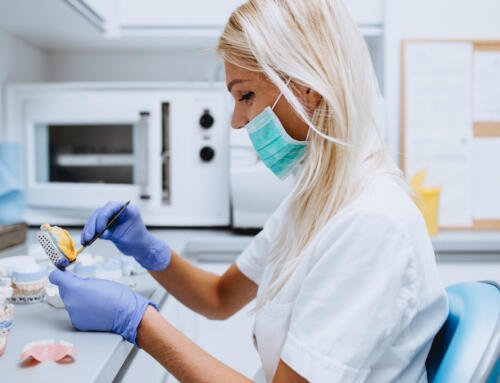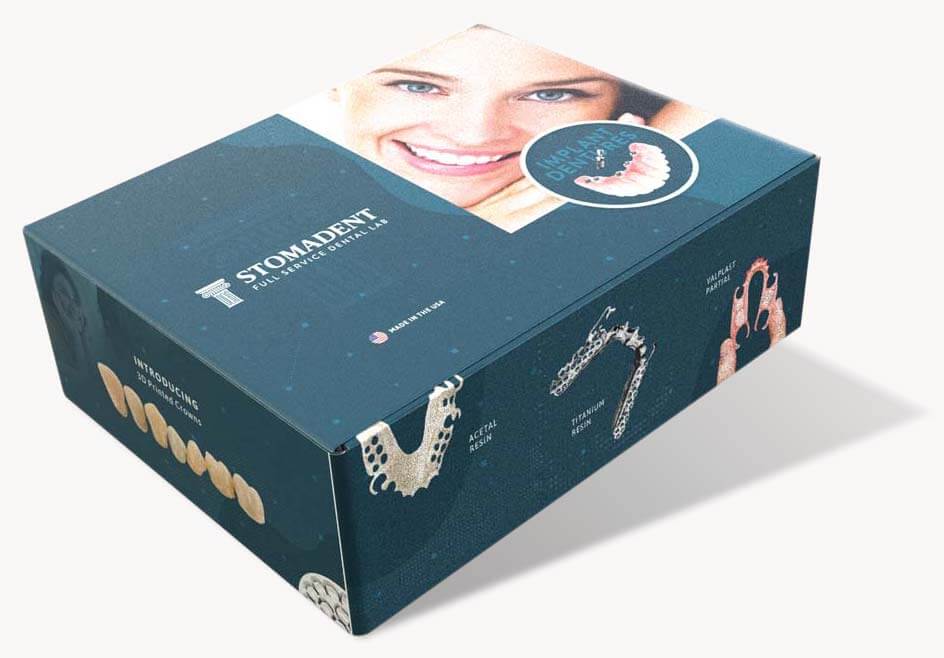
By David Hudnall, DMD
In this article, we’ll address one of the most common questions that Stomadent Dental Laboratory receives: “When should a dentist choose a Valplast partial instead of another partial denture, like an acrylic partial, a cast metal partial, or an Acetal Resin partial?”
Valplast is an excellent choice for patients who are looking for an extremely aesthetic removable restoration. A flexible partial denture offers one benefit that no traditional acrylic or metal framework partial can match –– absolutely no metal at all.
What is the Difference Between Valplast and Acrylic Dentures?
Acrylic partials have their place. They work well as immediate or temporary appliances while the patient transitions between a full mouth of natural teeth to a final restorative option. But, let’s face it – they are not extremely comfortable nor aesthetic.
Because the baseplate and clasps of Valplast partials are made from tissue-colored flexible nylon-based resin, they provide comfort while literally disappearing into the patient’s mouth for a seamless appearance with the natural teeth.
When To Choose a Valplast Partial
If you are considering Valplast, make certain that you are not working with an immediate partial case. We never suggest relining a Valplast partial –– ever. You don’t reline a Valplast partial. You remake it. Patient selection is important. Therefore, make sure the patient is not an immediate or a post-immediate.
We also don’t suggest using a Valplast appliance when the patient’s lower ridge is extremely resorbed. If the patient has thin tissue over a resorbed ridge, a Valplast partial may never be comfortable for them to wear.
With many other cases, Valplast works great. It is an excellent choice especially for patients who are looking for an extremely esthetic restoration where there are no visible metal clasps, cast clasps, or Acetal Resin clasps. These types of clasps aren’t as invisible and don’t look as good as Valplast gingival clasps.

Here in the dental chair, we have our patient. She is missing some of her upper teeth and will need a partial restoration. We can see her canine will be an anchor tooth for a partial. We would like to avoid placing a visible metal clasp on the canine.
Therefore, we choose a Valplast restoration. She also has some anterior teeth missing (lateral incisors). For this case, we will use gingiva-colored Valplast clasps around both of the canines. The Valplast restoration will be a great, aesthetic choice for this patient.
Valplast Restorations Are More Forgiving Than Metal or Titanium Partials
You can use either polyvinyl or the Accudent alginate system to take impressions. Both will work equally well. With Valplast, it is important to make sure that the borders of the impression are not over-extended. If the borders are kept shorter, the partial will actually have a better fit.
We have taken this patient’s impression with polyvinyl siloxane. Be sure the borders are not over-extended. With Valplast, there is no reason to take a preliminary impression followed by a final impression. You can directly take the final impression, eliminating unnecessary steps.
When it comes to doing a wax try-in of the teeth, do it only when it is absolutely necessary (i.e. for cases with questionable bite records). Otherwise omit the try-in entirely. The reason: after the try-in, the lab must remove all of the teeth from the baseplate and reposition them directly on the model.
This is because the baseplate of a Valplast partial must be fabricated with a very precise uniform thickness. The thickness of the material determines how well the final partial will fit in the patient’s mouth.
Taking a bite is very simple. Warm the bite rims so the wax is soft. Place the bite rim in the patient’s mouth and allow the patient to bite into the wax completely. Then cool the wax and remove the bite rim from the mouth. For cases with minimal missing teeth, you may record the bite using your favorite polyvinyl bite record material instead of the bite rims.
Why Try Valplast Partials?
Many dental professionals have tried Valplast partials before and they did not work well for them. They ask us, “Why does it work now?”
When we make a Valplast partial, we block out the buccal ridge tissue. It is extremely important to do that. When the partial settles into the mouth and against the patient’s palatal tissue, we don’t want the flange of the partial to cut into the buccal tissue or scrape the bone upon insertion.
Many labs avoid this block out step because a duplicate model is necessary. For a great-fitting Valplast partial, this step is extremely important and worthwhile. At Stomadent, we anticipate the partial will settle therefore we block out the buccal undercuts before we construct the partial. Doing this will prevent sore spots and numerous chairside adjustments.
We also pay close attention to the thickness of the partial. If the baseplate is slightly thick, the material becomes more rigid and more difficult to insert. This will cause the partial to gauge into the tissue. Stomadent takes the thickness of a Valplast partial very seriously. When you receive a Valplast partial from us, you will see that it does fit well.
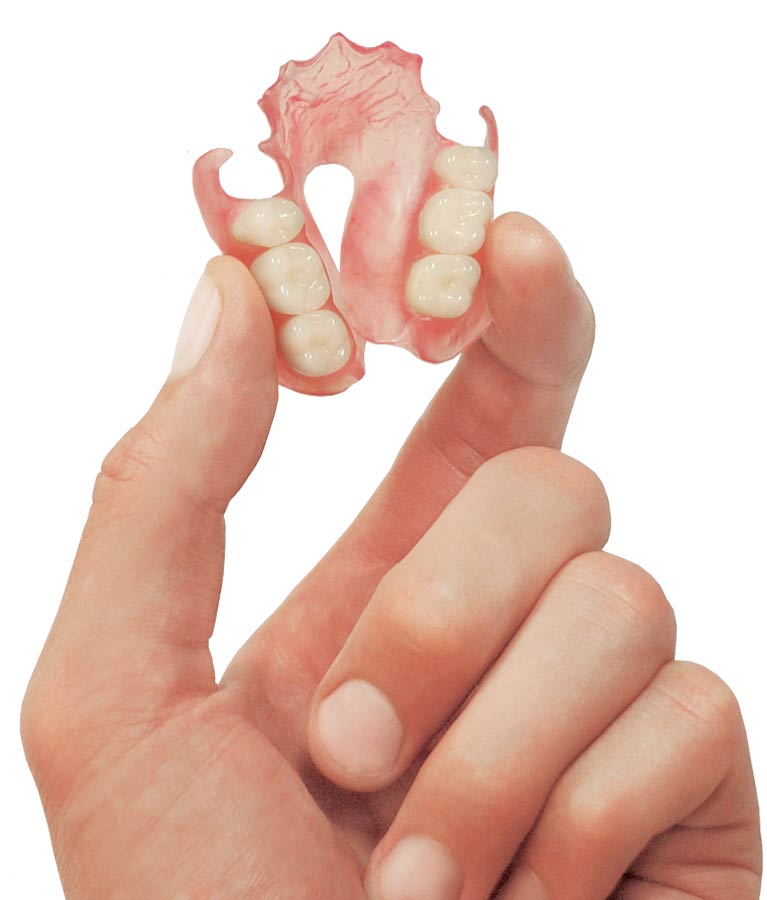
Delivering the Valplast Partial
We have the Valplast partial to deliver to the patient that we saw earlier. Before inserting the partial, place the partial in warm to hot tap water for five minutes. This will allow the material to become more flexible. By doing this, you will be able to insert the partial into the patient’s mouth more gently.
Once fully seated, the partial becomes nearly invisible in the mouth. With proper tooth and gingival shade selections, it is difficult to tell which teeth are real and which teeth are a part of the restoration. When the patient is looking for esthetics and a restoration that will not be visible, Valplast is the best choice. This is especially true for replacing missing teeth on the upper arch.
Valplast Partial Reviews: The Benefits
Superior aesthetics is a great reason to offer Valplast flexible partials to your patients. But that’s not the only consideration when choosing a removable restoration. Here are some other reasons to select a Valplast partial:
- An economical tooth replacement option
- Offers greater comfort compared to a rigid partial denture
- Totally metal-free and biocompatible
- Kind to abutment teeth that have periodontal bone loss or slight mobility
- Little to no tooth preparation required prior to fabrication
- Unbreakable when dropped
- Reversible procedure
- Can act as a temporary appliance while saving funds for future dental implants
- Valplast can be fabricated into a Nesbit appliance to replace one or two missing teeth
- The flexible material and clasps can be combined into a hybrid partial with a metal framework
Valplast Partial Reviews: The Disadvantages
For the case to be successful, patient selection is critical. There are a number of reasons to avoid prescribing a flexible partial. Flexible partials have certain material limitations and there are situations and tooth configurations where they just don’t work well. Here are the disadvantages of Valplast partial dentures:
- Not functional for posterior free-end partial cases
- Not suitable for replacing a long span of missing teeth
- Can be painful to wear on knife-edged or extremely atrophic ridges
- Baseplate material interferes with the occlusion on deep overbite cases
- Not appropriate for immediate- or post-immediate cases subject to tissue or structural changes
- It is far easier and more efficient to make a replacement flexible partial than to reline or rebase
- Limited life expectancy when compared with other types of partial dentures
- The flexible material is easily ruined by denture cleaning products or patient abuse
FAQs About Valplast Partial Dentures
How Long Does It Take to Make a Valplast Partial?
Stomadent Dental Lab can design and manufacture your Valplast removable partial denture within 5 working days, not including the day that it is received. Clasp repairs or tooth additions to Valplast partials using genuine Valplast materials may be accomplished usually within two full working days.
Are There Any Manufacturing Concerns?
Material thickness is critical and Stomadent takes the thickness of a Valplast partial very seriously during the manufacturing process. The material is intended to be quite thin and flexible for proper adaptation and intimate tissue contact.
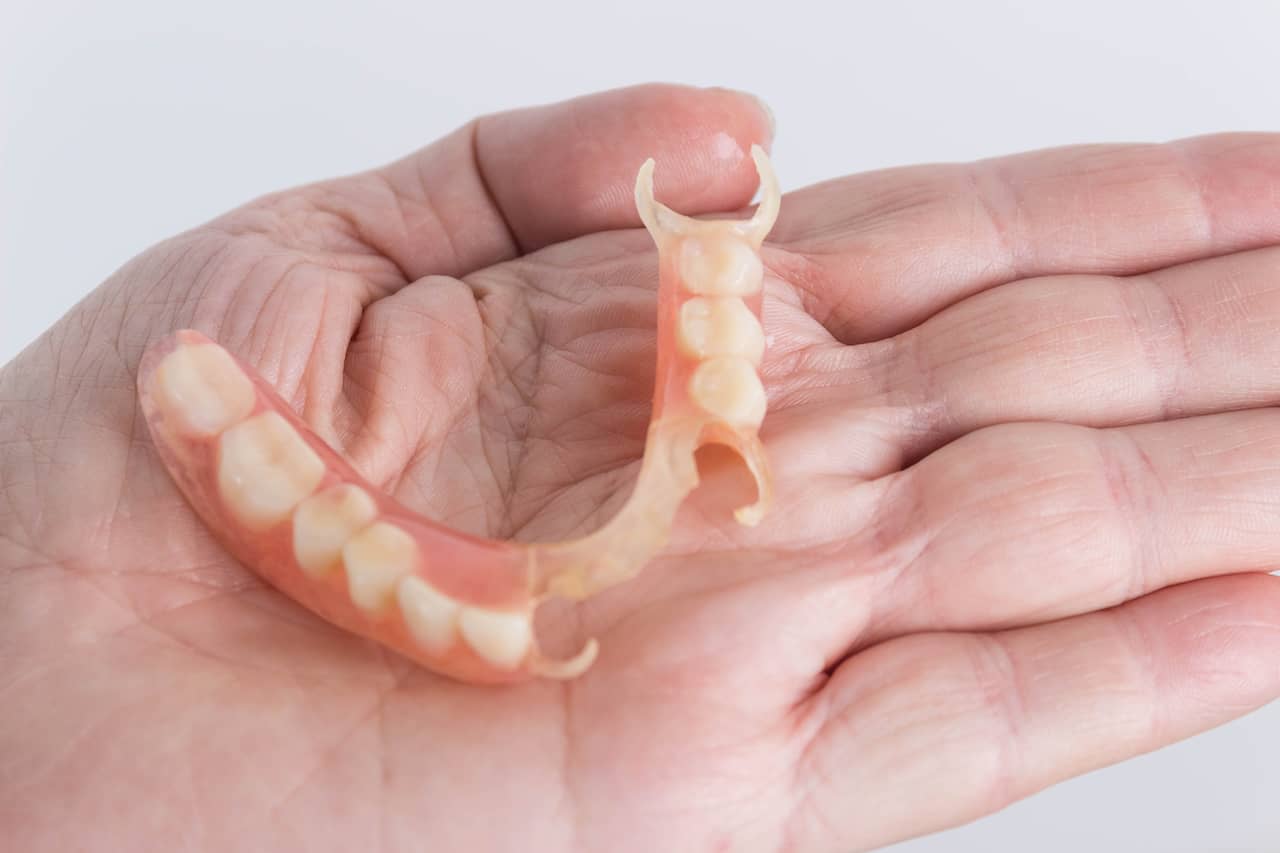
If the baseplate is too thick, the material becomes rigid and more difficult to insert. A thick baseplate will also cause the partial to cut into the tissue, especially along its borders. When you receive a Valplast partial from Stomadent, you will notice that it remains quite flexible and it slides into place comfortably without force.
What Is the Delivery and Adjustment Process?
Remember to place the flexible partial in warm tap water for at least five minutes prior to inserting it into the patient’s mouth. The heat from the water allows the material to become pliable and shape itself to the patient’s anatomy when fully seated. As the material cools, it will harden and conform to the new shape, reducing or eliminating the need for adjustments.
In the event that minor adjustments are required, they may be performed with stones, rubber wheels and points. An adjustment kit containing the recommended tools and the concentrated cleaner made specifically for use on Valplast flexible partials can be ordered on Valplast’s website.
How Much Do Valplast Partials Cost?
Valplast partials cost the dental professional between $300 to $500, depending on the tooth configuration and additional options chosen. Many patients search for this information and want to know what a Valplast flexible partial costs before they go to the dental office. A patient can expect the cost to range from $900 to $1,500, depending on their geographic location.
Do Patients Like Their Valplast Partials?
Valplast partial reviews are generally favorable when patient selection is appropriate and the partial is not being asked to function in a way that it was never designed to handle. The uses for flexible partials are somewhat different from other types of partial dentures. Flexible partials can often be used to fulfill needs that aren’t being addressed with traditional removable restorations.
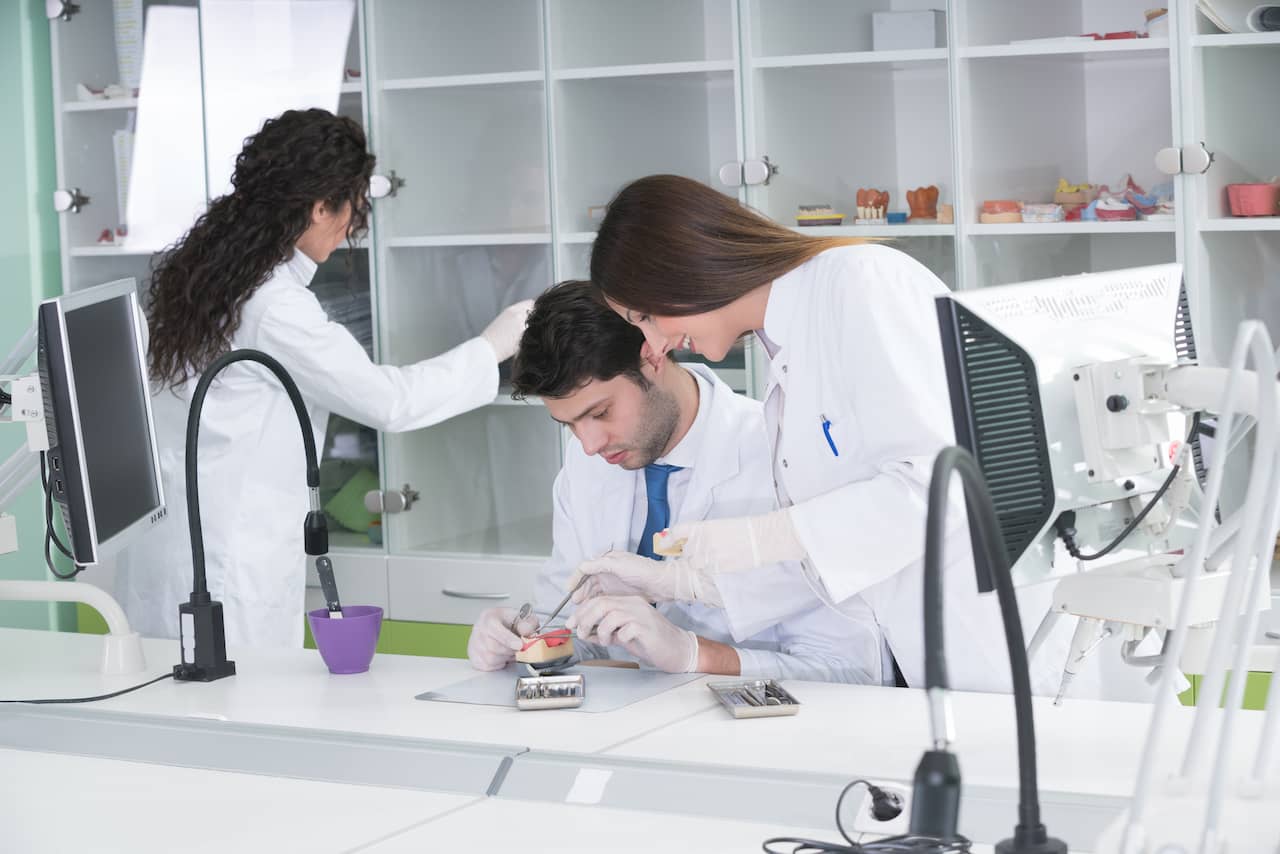
Stomadent: Your Source for Valplast Flexible Partials
Flexible partials made by an inexperienced laboratory can prove to be a disaster for everyone involved. And a negative experience at delivery often leaves both the patient and the practitioner frustrated and wondering whether they made the right partial denture choice.
As a Valplast certified provider, Stomadent Dental Laboratory provides your patients with high-quality flexible partials made according to the manufacturer’s exacting specifications and standards, allowing them to fit precisely upon delivery without time-consuming adjustments.
Trust Stomadent to give the patient the “WOW” moment that they were expecting. Visit our website to see Valplast flexible partial dentures plus the full line of Stomadent’s partial denture offerings.

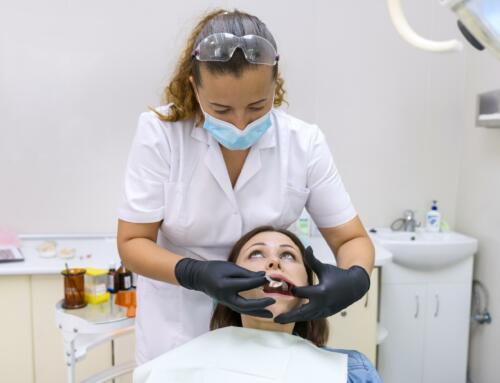
![Partial Denture Clasp Types [Assessing Clinical Situations]](https://stomadentlab.com/wp-content/uploads/2024/03/dental-implant-model-dental-bridge-in-hand-dentis-2023-11-27-05-11-13-utc-scaled-500x383.jpg)
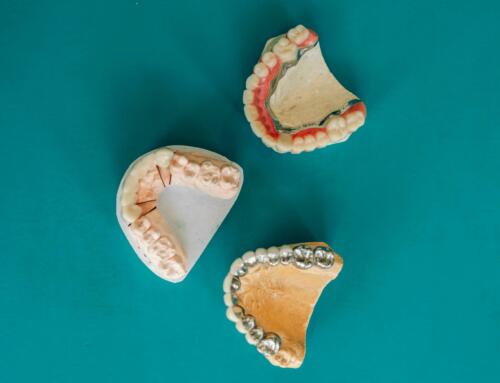

![TCS Flexible Partial vs Valplast [Comparing Denture Options]](https://stomadentlab.com/wp-content/uploads/2024/01/asian-elderly-woman-patient-use-toothbrush-to-clea-2023-11-27-05-03-35-utc-scaled-500x383.jpg)



